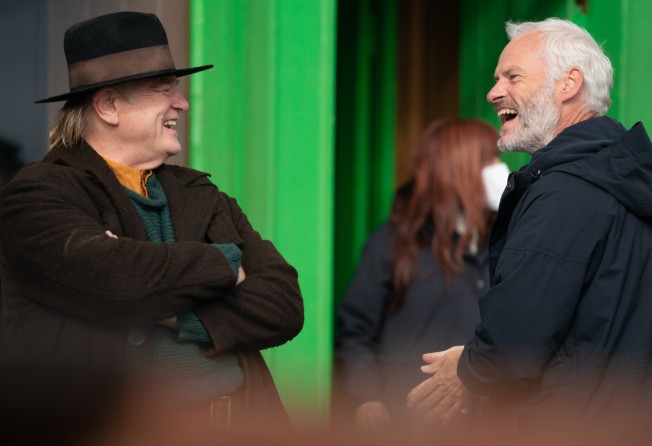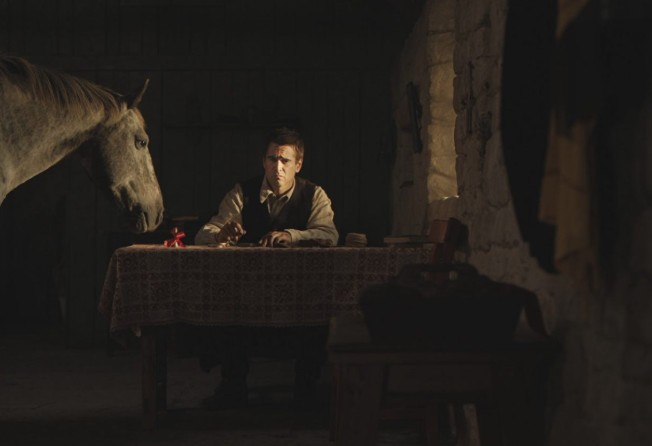From The Banshees of Inisherin to EO and Shrek, how the donkeys carry films in which they co-star
- The buzz when The Banshees of Inisherin premiered wasn’t about its comic narrative or Colin Farrell’s performance, but his character’s miniature donkey, Jenny
- From the 1966 Robert Bresson classic Au Hasard Balthazar to EO and Shrek, donkeys have added star quality to the films they co-star in

When Martin McDonagh’s film The Banshees of Inisherin premiered at last year’s Venice Film Festival, the post-screening buzz – at least in some quarters – wasn’t about the brilliance of Colin Farrell’s lead performance. Or the darkly comic nature of McDonagh’s fable, a grisly story of a friendship gone awry on a small island off the west coast of Ireland in the 1920s.
No, it was all about Jenny, the miniature donkey belonging to Farrell’s character Pádraic, a sheep farmer who lives with his sister Siobhán (Kerry Condon) in a small cottage.
Jenny, a black-furred creature who comes up to waist height on Pádraic, can be seen frequently trooping in through the front door or hanging out in the kitchen, much to the annoyance of Siobhán.
The doleful-looking creature provides great comfort to Pádraic, not least when his best friend, Colm (Brendan Gleeson), inexplicably decides to stop talking to him.
The reason? Preferring to create music for his fiddle in the time he has left, he no longer wishes to listen to Pádraic’s banal chatter about matters such as “the contents” of his donkey’s excrement.
McDonagh, the director behind In Bruges (which starred Farrell and Gleeson) and the double Oscar-winning Three Billboards Outside Ebbing, Missouri, found the idea of a miniature donkey amusing.
“I guess I just wanted one,” McDonagh says with a shrug.
The animals are very real in the place. It’s beautiful that they’re not anthropomorphised
The creature, who was making her screen debut, was partnered by her double, the older, more experienced donkey Nosy Rosie, whose presence would relax Jenny into performing on cue. Except when Farrell was on set.
As he recounted on chat show Late Night With Seth Meyers, “She gave me a good old clatter on the knee.”
Jenny is symbolic of Pádraic’s simple-but-kind nature. While others in the village refer to him as dull, especially after Colm no longer wants to be drinking buddies with him, his gentle demeanour is highlighted by his love for the miniature donkey.

The creature is too small to be of any practical use in this rugged, rural environment carrying goods or the like. But she serves as a loyal companion to Pádraic exactly when he needs one the most.
If the film is about how we find solace in the company of others, and the pain when that flounders, McDonagh wrote the film as a break-up movie. He wanted to imbue the story with “this sadness of any love affair that ends”, he says.
“I kind of wrote it from that perspective, I think. That was the most important thing for me. It just happened to be a platonic male one; it could have easily been a divorce movie.” Or even a story about the profound loss felt when an animal dies.
Beyond this, Jenny and the other beasts of burden in the film serve another, higher purpose. “The animals are very real in the place,” says Gleeson. “It’s beautiful that they’re not anthropomorphised, they’re not turned into people as such.
“Actually the people kind of more or less become in tune with the animals in a way. They find a little bit of that integration, against the donkey putting on funny faces. There were the little gifts that happened from the animals. They were very much a presence.”

While the animals were proper co-stars – a horse instinctively nuzzling Farrell at one point, while Jenny does her own fair share of donkey-to-man bonding – it’s about more than that.
“I do like that the animals are the observers of this descent into war,” says McDonagh, referring not just to Pádraic’s escalating clash with Colm but the Irish civil war that can be glimpsed in the distance on the mainland.
“By the end, they’re the only ones just seeing the horror … without being able to voice it. Just seeing this sadness.”
The film has already won McDonagh the best screenplay and Farrell a best actor prize at the Venice Film Festival and the Golden Globes and has since been nominated for a clutch of Baftas and Oscars.

Although one user on Reddit recently wrote: “Is Jenny the Donkey a contender for a best supporting actress nomination?”, sadly, there’s no precedent for four-legged nominees, although perhaps the Academy should give thought to a best animal performance category.
Curiously, Jenny isn’t the only braying star of the art house circuit this season. In the Cannes Palme d’Or-winning Triangle of Sadness, the wealthy patrons of a luxury cruise left shipwrecked on an island end up killing a luckless donkey.
While that would seem the perfect snapshot of human cruelty, the donkey is a mere casualty of war in Ruben Östlund’s savage satire.
Far more significant is the Sardinian donkey that takes centre stage in EO, the latest film from veteran Polish director Jerzy Skolimowski.
It follows the donkey Eo on a picaresque adventure through contemporary Europe, as it passively observes the best and worst of humanity.
“The film is dedicated to the idea of making people aware of the general treatment of human beings towards animals … they don’t see the animal as a living creature,” says the director.
“They tend to treat them as objects, and most of the time abusing … it leads to extremes, like the industrial production of meat where the animals are being kept in appalling conditions. It’s macabre, it’s a crime really.”
The only time when I shed a tear in the cinema. Never before, never after. And that was the greatest lesson
Skolimowski rotated between six different donkeys to shoot the film, with some better at close-ups, while others were more suited to “action” scenes.
“The donkey has this reputation of being stubborn and stupid,” he adds. “Stubborn of course yes, but I don’t agree that they’re stupid. They’re very intelligent, very sensitive animals.”
On set, he and his crew began to read the various donkeys’ moods. “[There was] never any force from our side and never pushing the animal, never shouting at all.”

EO is an homage to perhaps the greatest donkey movie ever made, Robert Bresson’s 1966 masterpiece Au Hasard Balthazar – recently voted the joint 25th greatest film of all time in Sight & Sound magazine’s once-a-decade critics’ poll.
Skolimowski saw that film upon release. “The only time when I shed a tear in the cinema. Never before, never after. And that was the greatest lesson which I got from Robert Bresson; the lesson that the animal character can move the viewer, the audience, stronger than any human character.”
In Bresson’s film, the donkey is maltreated by the humans it comes across, embodying man’s barbarism. French New Wave master Jean Luc-Godard even said, “this film is really the world in an hour and a half”, which might well be true – depressingly so.

Of course, donkeys are scattered throughout cinema, from Roberto Benigni’s Pinocchio to the Shrek franchise, with the creature memorably voiced by Eddie Murphy. But nothing will ever top Bresson’s beast – not even Jenny the miniature donkey.
Want more articles like this? Follow SCMP Film on Facebook